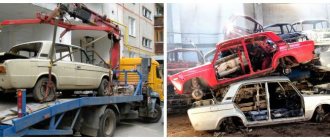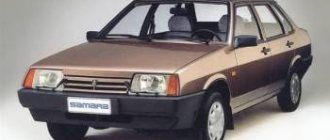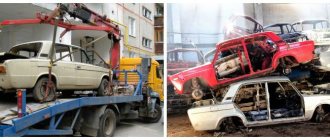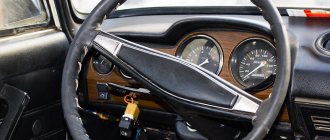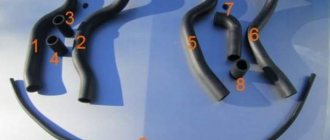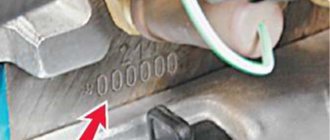How much the VAZ-2101 weighs is affected by the wear of metal parts, the presence of additional body kit and gas equipment. It should be noted that the vast majority of modern sedans are equipped with a monocoque body. “Kopeyka” is no exception in this case. This structure is a steel caisson, inside of which there are compartments for passengers, driver and luggage. In addition, the working units and components of the vehicle are located on the body.
Design features
Regardless of the weight of the VAZ-2101, the body not only experiences static stress from the equipment installed on it, but must also withstand its impact under dynamic load. This property of the box is called torsional rigidity. On the car in question, this figure is about 7300 Nm / deg.
This technical parameter is significantly influenced by the condition of the lower part, roof, and thresholds. This is due to the fact that these elements are connected to each other from the front panel. In addition, the strength characteristics and geometry of the body depend on the integrity of the door pillars, window panels and trunk cross member. You can check the correct symmetry and general condition of the car yourself. To do this, take the actual dimensions of the frame and compare them with the parameters specified in the car repair manual.
VAZ 2101 engine malfunctions and their symptoms
No matter how reliable the power unit of the “penny” is, it can also sometimes be capricious. The main signs of its malfunction are:
- inability to start;
- unstable operation at idle, tripping;
- reduction in traction and power characteristics;
- overheat;
- extraneous noise (knocking, clattering);
- the appearance of white (blue) exhaust.
Naturally, any of the listed symptoms cannot clearly indicate a specific malfunction, so let's look at them in more detail in the context of possible breakdowns.
Load distribution
From all of the above, it follows that the fatigue of the VAZ-2101 body directly affects the condition of the attachment points of components and assemblies, and is also manifested in the correct geometry of its front, rear and side openings.
When driving (in dynamics), the distribution of loads on the chassis is as follows:
- From the front suspension parts, vibration and mechanical moments are transformed into the cross member with subsequent transfer to the sub-engine part of the chassis.
- In addition, the force is transmitted to the surface of the wings and front deflector, called the load-bearing elements of the body.
- At the back, a similar image takes place in a more simplified form. The engine mounts are not involved here; the transition goes directly from the suspension to the car chassis.
Specifications
| Positions | Indicators | |
| VAZ 2101 | VAZ 21011 | |
| Type of fuel | Gasoline A-76, AI-92 | Gasoline AI-93 |
| Injection device | Carburetor | |
| Cylinder block material | Cast iron | |
| Cylinder head material | Aluminium alloy | |
| Weight, kg | 114 | |
| Cylinder arrangement | Row | |
| Number of cylinders, pcs | 4 | |
| Piston diameter, mm | 76 | 79 |
| Amplitude of piston movement, mm | 66 | |
| Cylinder diameter, mm | 76 | 79 |
| Working volume, cm 3 | 1198 | 1294 |
| Maximum power, l. With. | 64 | 69 |
| Torque, Nm | 87,3 | 94 |
| Compression ratio | 8,5 | 8,8 |
| Mixed fuel consumption, l | 9,2 | 9,5 |
| Declared engine life, thousand km. | 200000 | 125000 |
| Practical resource, thousand km. | 500000 | 200000 |
| Camshaft | ||
| location | top | |
| valve timing width, 0 | 232 | |
| value of the exhaust valve advance angle, 0 | 42 | |
| intake valve retard, 0 | 40 | |
| diameter of seals, mm | 56 and 40 | |
| width of seals, mm | 7 | |
| Crankshaft | ||
| Neck diameter, mm | 50,795 | |
| Number of bearings, pcs | 5 | |
| Flywheel | ||
| outer diameter, mm | 277,5 | |
| bore diameter, mm | 256,795 | |
| number of ring teeth, pcs | 129 | |
| weight, g | 620 | |
| Recommended Engine Oil | 5W30, 15W40 | 5W30, 5W40, 10W40, 15W40 |
| Engine oil volume, l | 3,75 | |
| Recommended Coolant | Antifreeze | |
| Coolant quantity, l | 9,75 | |
| Timing drive | Chain, double row | |
| Cylinder operating order | 1–3-4–2 | |
Material of manufacture
With this body and suspension configuration, the frame material plays an important role in the safety and stability of the vehicle. It is logical that strengthening the weak points of the body will make the car more rigid and stable on the road. But then the mass of the car will be critical, which will make it awkward and very heavy.
Strengthening the frame increases the weight of the “penny” and the load on all structural elements. That is why designers try to select the rational thickness of materials, taking into account the ratio of their sizes and sections. The result is a fairly strong and not too heavy body.
To reduce weight and save costs, non-structural elements are made from thinner metal. The thickness of the main parts is about a millimeter, which corresponds to those of other cars of the same class.
VAZ car body weight
The VAZ itself is susceptible to “body fatigue”, which manifests itself:
- Regarding control points of aggregate and unit fastenings.
- It also occurs when the side and front openings of the car begin to change their geometry, simply warping.
If we need to strengthen the body of a VAZ car, make it more rigid and stable, then the question will inevitably arise about its weight. By adding more mass when strengthening the frame, we will certainly increase the load on all other parts of the structure. By adding to this part the material from which the car body is made, we get a problem regarding strength of materials. Having correctly solved the dilemma, we will be able to correctly select materials of the required thickness with the correct ratio of sections and required dimensions.
The body of the VAZ-2101 car is so highly durable that even today car enthusiasts speak admiringly of it, telling various stories when, in a collision between a foreign foreign car and “our” car, what remains from the first is an “accordion”, and from the second only the paint on the hood flies off and, possibly, The radiator falls off.
VAZ owes its quality not only to the thickness of the metal, as is widely believed, but also to the highly professional personnel taking part in its production. Without new talented technical and engineering solutions, it would be difficult to achieve such quality.
How much does the VAZ-2101 weigh?
The tail of the “penny” is welded to the car’s chassis at the front and rear, which allows it to be inserted into the supporting circuit. This also helps reduce the weight of the car. Below is a layout of the main parts of the first Zhiguli model (in kilograms):
- engine with associated equipment - 140;
- exchange - 26;
- cardan shaft - 10;
- rear axle - 52;
- radiator - 7.0;
- body part - 280.
The total weight of the VAZ-2101 is 955 kilograms. It would seem that the figure is not very impressive. But when you multiply the remainder by all the units, of which 4.85 million were produced, it becomes clear that every gram saved makes a significant difference.
How much do VAZ cars weigh if they are sold for scrap?
Vehicles from the Volzhsky Automobile Plant were popular in the post-Soviet countries. These cars served their owners for many years; many still have their vehicles. That is why questions about the weight of VAZ cars when selling them for scrap do not surprise anyone. Almost all VAZ models are currently outdated and must be disposed of.
Features of recycling
Before you sell your car for scrap, you should familiarize yourself with the recycling procedure.
Let's start with the fact that the average weight of one VAZ car is one ton. More detailed values will be posted below. If the owner of the vehicle wants to recycle it completely, then at the collection point they will deduct 30% from him for garbage and other unnecessary non-metallic parts.
You can consider in detail using an example how much a VAZ 2105 weighs for scrap metal. The exact weight of this car is 955 kg. Taking into account debris and excess non-metallic parts, the vehicle will weigh 660 kg.
It should be remembered that the price of scrap metal in large and small cities varies greatly. Therefore, it is important to be interested in the cost of scrap, and not just how much a particular vehicle weighs. It is worth asking relatives, acquaintances or friends about the approximate price of one kg of scrap in the region of residence. This will reduce the risk of falling for scammers.
Also, before deciding to scrap a car, you need to think about its transportation. If the car is a pile of metal, then it must be delivered to the location by tow truck. If the car has wheels and a tow, then the cost of a tow truck is significantly reduced.
In order to find out how much a Zhiguli costs for scrap metal, you need to ask how much a VAZ 2109 weighs for scrap metal or how much a VAZ 21099 weighs for scrap metal. It is important to find out all the features of the venue, conditions, rules and follow them so as not to get into an unpleasant situation.
Self-analysis of VAZ
Some people who find out how much a VAZ 2101 body weighs for scrap metal decide to disassemble it themselves. You can remove all the expensive parts, sort them, recycle them and receive revenue. Only in this case will self-disposal be beneficial.
A little more about VAZ
To better understand the topic, it is important to consider a couple more examples.
How much does a VAZ 2107 weigh for scrap metal? Its mass ranges from 1030 to 1060 kg. If you subtract 30%, it turns out that the owner of the vehicle will only be paid 721-751 kg of scrap metal.
How much does a VAZ 2106 weigh for scrap metal? The mass of its body is about 300 kg. Motor – 140 kg. Mosta – 52 kg.
You should not dispose of a vehicle yourself without certain skills. It is better to take it to a specialized point where disposal will be quick and safe.
Additional processing measures
It is worth noting that with dimensions of 4.07 / 1.61 / 1.44 meters, the machine in question has a fairly acceptable weight. The strength and integrity of the body is affected not only by how much a “penny” weighs and how thick the metal is, but also by factory quality and independent anti-corrosion treatment.
According to the rules, after welding operations, before painting, the car body must be phosphated. During this treatment, the entire surface of the frame was covered with a special phosphate film that is resistant to chemical attack. In addition, the effect was secured by applying a primer layer, which was sprayed by electrophoresis. This allowed the primer to provide even coverage in hard to reach areas. The car floor is treated with a special reinforced mastic, which reliably protects the floor from exposure to aggressive environments.
Tuning
- The tuning option with an increase in volume involves boring the cylinders and replacing the pistons with spare parts from older VAZ engines. Such work is somewhat difficult and can be expensive. It is necessary to bore the cylinders, replace the pistons and crankshaft. It is often easier to carry out an engine swap by installing an engine from a VAZ five or six.
- Installing a turbine can be considered solely in theory, since this tuning option leads to rapid failure of the VAZ 2101, the engine tuning of which was performed using a turbine and compressor. An engine with an installed turbine has a service life of about 20 thousand kilometers, while the power indicator in rare cases exceeds the 100 horsepower mark. This option is used only for cars participating in drag racing, where car owners do not care about the life of the car, but only the technical characteristics of the forced engine are at the forefront.
Interesting Facts
Until today, classic VAZ cars have retained their original configuration and the love of people, regardless of age and social status. The engineers of the Volzhsky Automobile Plant do not even think of stopping there, developing and producing new modifications.
It is noteworthy that of all Soviet passenger cars, only the “kopek” was supplied to the Land of the Rising Sun. The popularity of the models in question owes much to Kimi Raikkonen, who achieved his first successes and victories with this car. The father of the legendary racing driver considered this car one of the most reliable representatives of its segment.
If you find out how much the VAZ-2101 and its followers weigh, you can note that over its half-century history this figure for the brand in question ranged from 0.95 to 1.3 tons. No significant or fundamental changes have occurred in this direction.
In conclusion
“Kopeyka” is rightfully called a legend of Soviet automobile production. People appreciated this car for its reliability, practicality and affordability. This modification has not been produced for a long time, but it can be purchased on the secondary market. There are quite well preserved copies. In addition, the VAZ-2101 represents a limitless field for tuning. Craftsmen “put their hand” to literally all parts of the car, from equipping the interior to modifying the body and power unit.
Maintenance
| Maintenance object | Time or mileage (whichever comes first) |
| Valve train chain | replacement after 100,000 km |
| Battery | 1 year/20000 |
| Valve clearance | 2 years/20000 |
| Crankcase ventilation | 2 years/20000 |
| Belts that drive attachments | 2 years/20000 |
| Fuel line and tank cap | 2 years/40000 |
| Motor oil | 1 year/10000 |
| Oil filter | 1 year/10000 |
| Air filter | 1 – 2 years/40000 |
| Fuel filter | 4 years/40000 |
| Heating/Cooling Fittings and Hoses | 2 years/40000 |
| Coolant | 2 years/40000 |
| Oxygen sensor | 100000 |
| Spark plug | 1 – 2 years/20000 |
| Exhaust manifold | 1 year |

